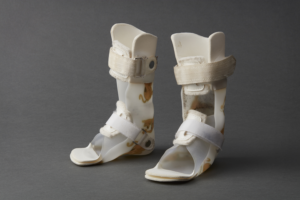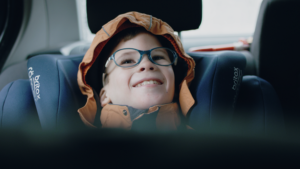 Some of the most heartwarming aspects of the 3D printing industry involve the people who do everything they can to develop and provide affordable 3D printed prosthetics to people who need them the most. Just in time for Father’s Day, Formlabs has shared a beautiful story about a dad who worked tirelessly to help his young son walk on his own…and ended up helping others along the way.
Some of the most heartwarming aspects of the 3D printing industry involve the people who do everything they can to develop and provide affordable 3D printed prosthetics to people who need them the most. Just in time for Father’s Day, Formlabs has shared a beautiful story about a dad who worked tirelessly to help his young son walk on his own…and ended up helping others along the way.
Cerebral palsy (CP) causes more than 17 million people around the world to have limited control of their own bodies. Seven years ago, Nik, the son of Matej and Mateja Vlašič, was born one month early, and due to difficulties during childbirth, suffered brain damage that led to the diagnosis of CP, and an inability to stand or walk on his own.
To help CP patients walk, many doctors will prescribe standard orthoses meant to correct spine and limb disorders. Patients can purchase pre-made orthotics, and some can even be slightly modified to better fit the patient, but it’s not easy to use one device to help with several symptoms, and they can even lead to skin irritation and pain.
Custom orthoses, CNC machined based off of a plaster or foam box impression, generally fit better, but the cost can be astronomical, even with insurance, and delivery can take weeks. On top of that, children outgrow them quickly.
Matej, who has an engineering background, said, “Based on my knowledge, I knew that a piece of plastic could not cost so much money.”
Matej has worked hard all of Nik’s life to help him move on his own, even using ski boots to stabilize his ankles when he got older.
- Traditional orthosis
“When you’re looking at your child, you instinctively know what to do in order to help him. When Nik was unable to turn on his side, I decided to build a ramp so that he could easily flip on his belly. When he found out that this was fun, he was trying to do it all by himself,” Matej said.
“He instantly felt confident, and you could see it in his eyes that he loved it and that he wanted to progress. This is what kept us going.”
Unfortunately, Nik’s short Achilles tendon and low muscle tone kept him on his toes.
“He was afraid of walking because his feet were in a really bad position,” said Petra Timošenko, Nik’s physiotherapist. “If he had tried to walk longer like that, he would have injured the bones and the joints.”
 Matej knew he had to find a better way to help his son.
Matej knew he had to find a better way to help his son.
“The lack of comfort and high price combined with all the cons were enough that I decided to do something about it. I didn’t have the solution at that time, but I wanted to find a better way to design it,” Matej said. “I was just trying to help my son the best possible way.
“I didn’t know how orthoses are produced currently, so I was able to look outside of the box.”
He had heard of 3D printing, and after conducting some research, determined that the technology was accurate enough to create a properly-fitted orthosis. One of the benefits of 3D printing, especially in the healthcare field, is its ability to design customized products at a more affordable cost, and Matej was confident he could create a custom, 3D printed orthosis that would give Nik the correction and support he needed.
After a few attempts, Matej successfully digitized Nik’s feet, learned 3D modeling, and spent the next six months researching and experimenting, and eventually developed an innovative workflow, which starts with placing the patient’s feet, in the corrected, standing position, on a vacuum bag.
An iPad-mounted structure scanner scans the footprints from the bag, while the feet are also 3D scanned from above, and the data is merged and cleaned up into an accurate representation. The custom orthosis is designed right on the 3D scanned foot in CAD software, and then 3D printed in high resolution on a Form 2 3D printer with Durable Resin.
The first 3D printed prototype reached almost to Nik’s knee and kept him from walking freely, so Matej got to work on the second iteration, creating a prototype that fit inside a regular shoe. Finally, a successful prototype was created.
“In two or three days he was walking, and we were not needed to take care of him so that he doesn’t fall anymore,” Matej said. “The change was immediate, it was unbelievable.”
Just how braces align teeth, the 3D printed orthosis keeps Nik’s foot in the corrected position. It’s best to use orthoses at a young age, as children’s bodies can adapt while they grow. Physiotherapy also helps to strengthen ligaments and muscles.
“When he’d been using the orthosis for two or three months, for the first time, I saw Nik smiling,” said Timošenko. “After four or five months, he started to become faster and faster. His steps became longer, and his walking more smooth. He actually started to dance.
“Now I can do much more sophisticated exercise with him. We can run on a treadmill, we can jump, because I know that his feet are in the right position and I can’t cause any deformation to his bones or joints, that might, on the long term, require an operation to correct. If he didn’t have this orthosis, his feet would be in danger.”
Matej created four versions of Nik’s 3D printed orthosis.
“The first version gave him confidence and stabilized him. The second version improved his overall walking smoothness,” Matej explained. “Then the third helped him get better posture, and that’s when he really started to enjoy the walking and started to play around. The fourth orthosis corrected his right foot that was off the center of his body, so now he’s able to stand with his feet together in a straightened, upright position.”
After looking at the workflow, and measuring Nik’s feet with and without his 3D printed orthoses, certified orthotist and prosthetist Dejan Tašner knew that Matej had created a novel solution. He is able to make an affordable custom orthosis in less than 24 hours, and the devices are also comfortable.
“3D printing allows us to create orthotics with different thicknesses in different areas. We can apply a more thick area where it’s needed and minimal thickness to the areas where correction is not required,” Matej explained. “This is not possible with current solutions.
“Orthoses don’t need to hurt, only without pain can the children accept them.”
Matej and his wife decided to certify the workflow, which is now patent-pending, so the process and components will meet standard requirements for medical devices and allow for clinical trials. Matej quit his job to focus on 3D printed, patient-specific 3D printed children’s orthotics full-time and, together with Mateja, Tašner, and Timošenko, formed a new company called aNImaKe.
“At the moment, we are testing with several patients with different pathologies from age three to 11,” Tašner said. “We already see improvements in terms of biomechanics, which is the main goal. But also, crucially, a positive change in sentiment that the parents see in the daily life of their children because they need to feel comfortable to use the orthosis often enough to improve their walking.”
aNImaKe hopes to expand the technique to other parts of the body, such as a hand brace that helps young CP patients spread their fingers.
“We want to enlighten others in the medical industry about the tools that are available today to provide better options to the children,” Matej said. “Orthotics should be built for a person, and should treat only the symptoms, not be standardized solutions that put them in boxes.”
Discuss this and other 3D printing topics at 3DPrintBoard.com or share your thoughts below.
[Source/Images: Formlabs]
Subscribe to Our Email Newsletter
Stay up-to-date on all the latest news from the 3D printing industry and receive information and offers from third party vendors.
You May Also Like
3D Printing News Unpeeled: A $3000 SLS System, Construction Subsidies and Parameters
The Housing Affordability Crisis is one of Canadian President Trudeau’s biggest issues. Now the government has made subsidies available, including scaling new technologies, 3D printed housing and libraries of reapproved...
“Bundled Light” Enables High Quality Plastic 3D Printing from LEAM
Naturally, we expect current 3D printing methods to continuously improve, but it continues to do so in the most surprising ways. The latest development comes from LEAM, a startup spun...
Each to Their Own: Exploring Creality’s Latest Ender Trio as the Company Strengthens Its Commitment to 3D Printing Advocacy
Creality has reaffirmed its commitment to promoting 3D printing. The launch of the Ender-3 V3 SE, Ender-3 V3 KE, and Ender-3 V3 showcases the company’s dedication to catering to diverse...
3D Printing News Briefs, March 23, 2024: AM in the US Coast Guard, Navy, & More
In today’s 3D Printing News Briefs, we’re discussing the use of 3D printing in various branches of the military, including the U.S. Coast Guard, the U.S. Navy, and the German...






































